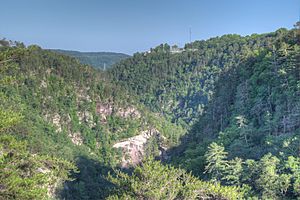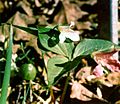Tallulah Gorge facts for kids
The Tallulah Gorge is a huge canyon in Georgia, USA. It was carved by the Tallulah River cutting through a special rock area called the Tallulah Dome.
This amazing gorge is about 2 miles (3.2 km) long. It has rocky cliffs that reach up to 1,000 feet (305 meters) high! Inside the gorge, you'll find a series of waterfalls called Tallulah Falls. These falls drop a total of 150 meters (492 feet) over just one mile (1.6 km).
Tallulah Falls is actually made up of six different waterfalls:
- l'Eau d'Or (46 ft or 14 m)
- Tempesta (76 ft or 23 m)
- Hurricane (the tallest at 96 ft or 29 m)
- Oceana (50 ft or 15 m)
- Bridal Veil (17 ft or 5.2 m)
- Lovers Leap (16 ft or 4.9 m)
The gorge is right next to the town of Tallulah Falls, Georgia. Most of the gorge and its waterfalls are protected within Tallulah Gorge State Park. It's so special that it's one of the Seven Natural Wonders of Georgia!
Just above the falls is Tallulah Falls Lake. This lake was made in 1913 when a dam was built. The dam was created by Georgia Railway and Power (now Georgia Power) to help power Atlanta's streetcars. Today, the dam still sends most of the river's water through a long tunnel, about 6,666 feet (2,032 m) long. This tunnel carries water around the falls to a power station downstream.
Only a few days each year is a lot of water released into the gorge. These "release days" are very popular! People love to visit for fun activities like kayaking and whitewater rafting.
Contents
A Look Back: History of Tallulah Gorge
People have been visiting Tallulah Gorge and its waterfalls for a long time. It became a popular tourist spot in the early 1800s.
In 1882, the Tallulah Falls Railway was built. This made it much easier for tourists from Atlanta and other parts of Georgia to visit. The gorge quickly became the first big tourist attraction in North Georgia. Hotels and shops opened to serve the many visitors. After the railway was built, as many as 2,000 people would visit on a single Sunday!
Tightrope Walkers and Dams
In 1883, a tightrope walker named Professor Bachman walked across the gorge. This was a stunt to get more attention for one of the hotels. Many years later, on July 18, 1970, Karl Wallenda became the second person to walk across the gorge on a tightrope.
In the 1910s, Georgia Railway and Power started building dams on the river. The town of Burton, Georgia, was bought and flooded to create Lake Burton in 1919. Many local people were against building these dams.
The Fight to Save the Gorge
One person who fought hard to protect the gorge was Helen Dortch Longstreet. She was the widow of a famous Confederate general, James Longstreet. In 1911, she led a campaign to make Tallulah Gorge a protected state area.
However, the Georgia Assembly couldn't raise the $1 million needed to buy the gorge. Helen Longstreet's effort was one of the first big conservation movements in Georgia. Even though she didn't succeed, her fight was important.
When the dam was finished in 1913, the loud roar of Tallulah Falls became quiet. Before the dam, you could hear the falls for miles! As the roar faded, fewer tourists came to visit. Later, Tallulah Gorge State Park was created by Georgia governor Zell Miller with help from Georgia Power.
What's in a Name?
In the late 1800s, some people promoting tourism said that "Tallulah" meant "loud waters" in the Cherokee language. But this isn't true! The word "Talula" is actually from the Itsate Creek language. It means a small town with one mound. In Muskogee-Creek, the same word is "talufa."
Some sources say "Tallulah" means "leaping water" in Choctaw. However, the Choctaw word for water is "oka."
How Tallulah Gorge Was Formed
The Tallulah Dome is a special rock formation. It was created when the Earth's crust folded twice. This happened when the supercontinent Pangaea was forming, about 500 to 250 million years ago. The dome is mostly made of strong rocks called quartzite and schist.
Plants and Animals of the Gorge
Because the gorge has steep cliffs, it gets different amounts of sunlight, shade, and moisture. This creates many different ecosystems inside and around the canyon.
One very special plant that grows here is the Persistent trillium. This is an endangered species of trillium. It only grows in this river basin and a few other places in the South Carolina and Georgia area.
Images for kids
-
Hawthorne Pool inside Tallulah Gorge State Park
-
View of the Tallulah River at the bottom of the gorge









